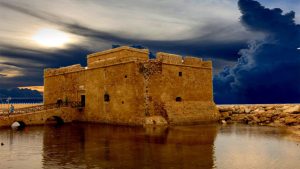
Paphos, located in the southwestern part of Cyprus, holds great historical and cultural significance. It was the capital of an ancient kingdom and renowned as a center of worship for the goddess Aphrodite.
The city is divided into two main areas: Paphos, known as the upper town and commercial center, and Kato Paphos, situated along the coast and serving as the primary tourist destination on the island. The entire archaeological site of Paphos has been protected by UNESCO since 1980.
With a history spanning nearly 4,000 years, Paphos has evolved into a vast open-air museum, making it a true treasure. The remarkable mosaics discovered after extensive excavations in Kato Paphos, specifically in the Houses of Dionysus, Aion, and Theseus, have been exceptionally preserved underground for 16 centuries until their accidental discovery in recent years. They offer a captivating glimpse into the past.
In the same vicinity, you can find the Tombs of the Kings, believed to be a luxurious burial site from the Roman era dating back to the 4th century. The Column of St. Paul stands as a testament to the apostle’s persecution and flogging by “forty but one” individuals as a punishment for spreading his religious teachings. Adjacent to it, underground catacombs such as St. Solomoni and Agios Lamprianou served as early Christian places of worship during times of persecution. Agia Solomoni, in particular, features preserved frescoes.
Additionally, the area housing the mosaics is home to three theaters, of which two have survived. The most famous is the “Ancient Odeon” of Paphos, a Roman theater that is still used for performances today. Near the Ancient Odeon, remnants of the Paphos walls, the ruins of the Roman Forum, and the Asklepieion can be explored.
Among the more recent landmarks is the “Forty Columns” Castle, a relic from the Lusignan era. Another iconic structure is the Paphos Castle situated at the harbor, originally constructed by the Byzantines and later reinforced by the Lusignans in the 13th century to protect the harbor from invaders.
All of these remarkable sites have been integrated into an archaeological park that stretches from the harbor to the Tombs of the Kings. Accessible only to pedestrians, the park continues to attract numerous missions from foreign universities for ongoing excavations, as only a small percentage of the area has been fully explored.
Paphos’ distinction as Europe’s cultural capital is well-deserved, owing to its rich cultural heritage and historical significance.


